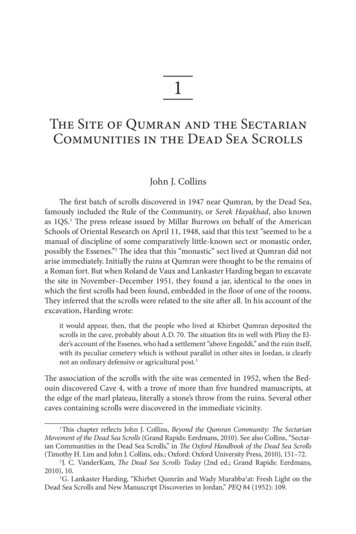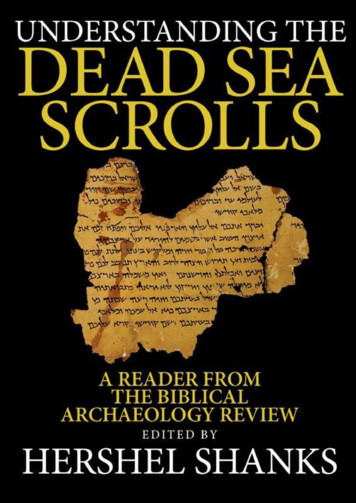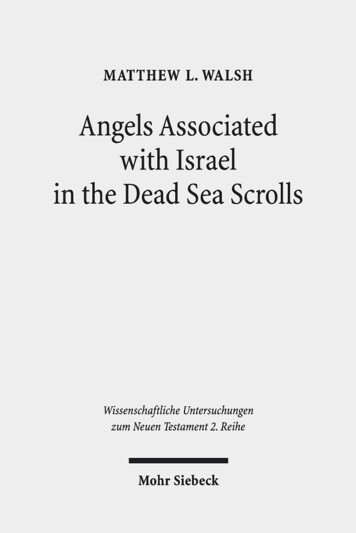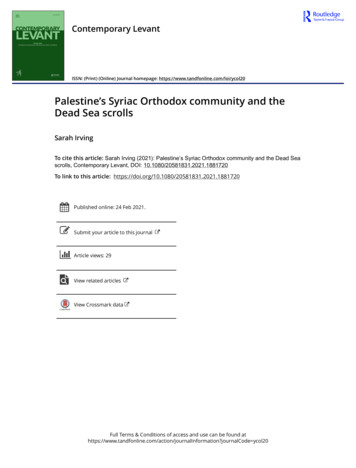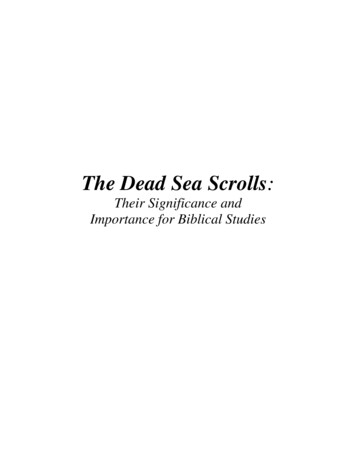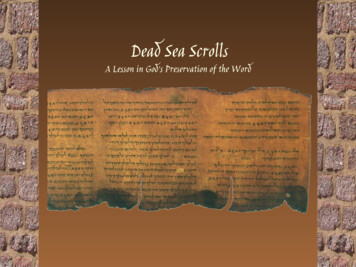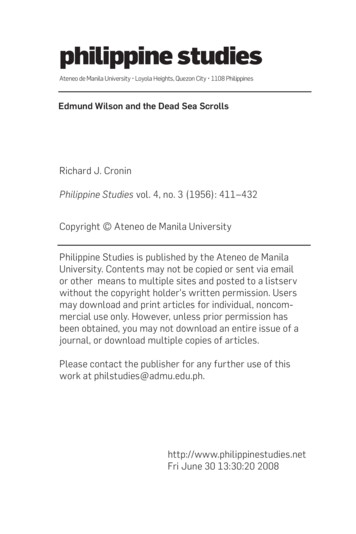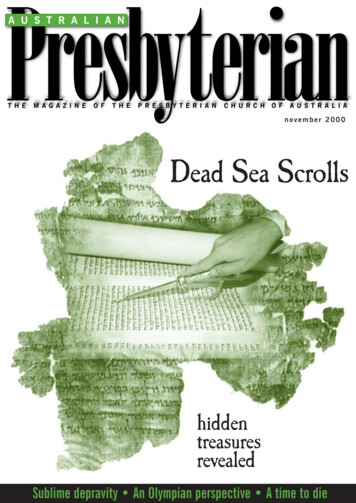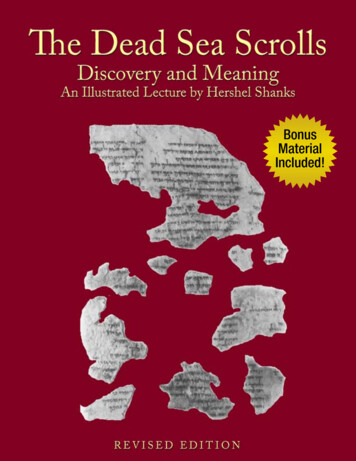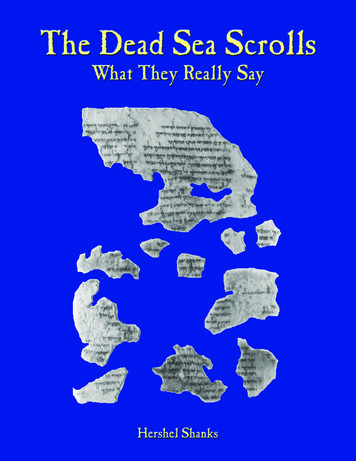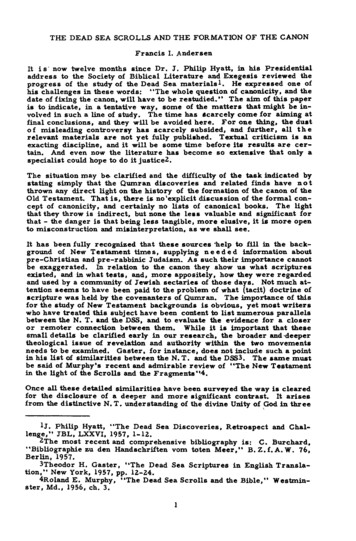
Transcription
THE DEAD SEA SCROLLS AND THE FORMATION OF THE CANONFrancis I. AndersenIt i s now twelve months since Dr. J. Philip Hyatt, in his Presidentialaddress to the Society of Biblical Literature and E x e g e s i s reviewed theprogress of the study of the Dead Sea materials 1. He expressed one ofhis challenges in these words: "The whole question of canoni city, and thedate of fixing the canon, will have to be restudied." The aim of this paperis to indicate, in a tentative way, some of the matters that might be i n volved in such a line of study. The time has Scarcely come for aiming atfinal conclusions, and they will be avoided here. For one thing, the dustof misleading controversy has scarcely subsided, and further, all t h erelevant materials are not yet fully published. Textual c r i t i c i s m i s anexacting discipline, and it will be some time before its results are c e r tain. And even now the literature has become s o extensive that only aspecialist could hope to do it justice .The situation may b e clarified and the difficulty of the task indicated bystating simply that the Qumran d i s c o v e r i es and related finds have n o tthrown any direct light on the history of the formation of the canon of theOld Testament. That i s , there is no explicit discussion of the formal c o ncept of canonicity, and certainly no l i s t s of canonical books. The lightthat they throw i s indirect, but none the l e s s valuable and significant forthat - the danger is that being l e s s tangible, m o r e elusive, it is m o r e opento misconstruction and misinterpretation, as we shall s e e .It has been fully recognized that these s o u r c e s 'help to fill in the background of New Testament t i m e s , supplying n e e d e d information aboutpre-Christian and pre-rabbinic Judaism. A s such their importance cannotbe exaggerated. In relation to the canon they show us what scripturesexisted, and in what t e s t s , and, m o r e appositely, how they w e r e regardedand used by a community of Jewish sectaries of those days. Not much attention s e e m s to have been paid to the problem of what (tacit) doctrine ofscripture was held by the covenanters of Qumran. The importance of thisfor the study of New Testament backgrounds i s obvious, yet m o s t w r i t e r swho have treated this subject have been content to l i s t numerous parallelsbetween the N. T. and the DSS, and to evaluate the evidence for a c l o s e ror remoter connection between them. While it i s important that thesesmall details be clarified early in our r e s e a r c h , the broader and deepertheological issue of revelation and authority within the two movementsneeds to be examined. Gaster, for instance, does not include such a pointin his l i s t of similarities between the N. T. and the DSS3. The s a m e mustbe said of Murphy*s recent and admirable review of "The New Testamentin the light of the Scrolls and the Fragments " 4 .Once all these detailed s i m i l a r i t i es have been surveyed the way i s clearedfor the disclosur e of a deeper and m o r e significant contrast. It a r i s e sfrom the distinctive N. T. understanding of the divine Unity of God in three! j . Philip Hyatt, "The Dead Sea D i s c o v e r i e s , Retrospect and Chall e n g e / ' JBL, LXXVI, 1957, 1-12.¿The most recent and comprehensive bibliography i s : C. Burchard,"Bibliographie zu den Handschriften vom toten M e e r , " B. Z . f . A . W . 76,Berlin, 1957.3Theodor H. Gaster, '«The Dead Sea Scriptures in English T r a n s l a tion,*' New York, 1957, pp. 12-24.4Roland E. Murphy, "The Dead Sea Scrolls and the B i b l e , " Westmins t e r , Md., 1956, eh. 3.1
living persons. The Incarnation transformed the function of Scripture i t s new rich purpose was to witness that Jesus was the Christ. The gift ofthe Spirit established the principle sola scriptura, since now the words ofthe books were perceived to be the direct speech of the living God. Allthis i s absent from Qumran, and gives its writings a sterile quality overwhich we might write with fairness "The letter k i l l s , " leaving the r e s t ofthe motto for the N . T . At the same time, that barrenness was a witnessthat the time for Messiah had come (in a way the Covenanters would nothave recognized), and their laudable devotion to their own scriptures hada pathos which showed that "that which decayeth and waxeth old i s readyto vanish away" (Heb. viii 13).All this i s a little too theological for our immediate aim of investigation,but it needs to be said to avoid the danger of seeing too much in outwards i m i l a r i t i e s , and to a v o i d surprise that two movements contiguous inspace and time, and with so much in common, could yet be two totally d i s tinct worlds. It was Christ who made the difference, and he transformedeverything. There i s nothing like him to be found at Qumran, not even asan extravagant hope. And for us he has transformed the doctrine of Scripture, even as his gift of his Spirit to the Church has transformed the roleof Scripture in the world.1. The Qumran c o v e n a n t e r s were clearly a Bible-center ed, Biblerevering, Bible-studying sect. There i s nothing remarkable about this forJudaism. It i s not surprising that there i s no explicit discussion of theextent or nature of their sacred scriptures, since it was probably takenfor granted. Sectaries tend to emphasize their peculiar beliefs to justifytheir separation, and the men of Qumran did that too; but scripture wascommon ground with other Jewish groups. But i s there any indirect wayof telling what their Bible was ? They owned and used not only books ofthe (later) Palestinian Canon, but also many that later found their way intothe so-called Alexandrian Canon, I . e . , books recognized by the RomanChurch as deuterocanonical, d e s i g n a t e d Apocrypha by the Reformedchurches. In addition, they had works of the kind usually called pseudepigraphical, some k n o w n from elsewhere, some not otherwise attested.Beside s these they had a literature of their own which was probably theproduct of the movement. This l a s t group covers a remarkably widerange of literary genres - commentary, psalm, handbooks of disciplineand of war ( ? ) . The movement clearly attached the greatest importanceto the written word, and the archaeological recovery of their scriptoriumin what was evidently the headquarters of this group, d i s c l o s e s the prominence of copying as an activity of the m e m b e r s .In the light of this it i s not surprising that reading, learning and copying(?) the holy writings are enumerated as among the aims of the movementsor as some of the marks of the pious man. The Manual of Discipline laysdown the rule:"The General m e m b e r s of the community are to keepawake for a third of all the nights of the year reading book. . . ( ? ) studying the Law and worshipping together."5This i s not "searching the s c r i p t u r e s " in the New Testament s e n s e , oreven in the s e n s e of P s s . 1 and 119. It was communal worship. We do not5**Meaning * a third of every night! . . . t h e entire membership (inshifts) filling the whole night with exposition (or oral m i d r a s h ) ." WilliamH. Brownlee, "The Dead Sea Manual of D i s c i p l i n e , " B.A.S.O.R., sup. Stud.N o s . 10-12, New Haven, 1954, p. 24, n. 14.2
know how individual m e m b e r s studied the scriptures6. There i s no evidence that they enjoyed liberty of interpretation or that the s e c t prizedm y s t i c a l insight or used it as a key to the meaning of Scripture.7 Thisshows 'that they had no notion of the sufficiency of Scripture. To themstudy was the inculcation of the e s o t e r i c wisdom peculiar to the s e c t; theywere instructed in the orthodox sectarian interpretations which, while theywere imparted to lay initiants, could not be d i s c u s s e d in publico.The Zadokite Fragment (Damascus Document), if w e may u se it, s a y snothing clear about the use of inspired writing» as an activity of the groupto which it applies, and the Hymn of the Initiants (columns χ and x i of theManual of Discipline) does not mention it as a mark of the pious man. Ofcourse there are many indications that the ideal of the community wa s tokeep the covenant and to obey the Law, and so on9. But always betweenthe devotee and the Book c o m e s the figure of the interpreting priest*0, andespecially of the T e a c h e r of Righteousness (or the one who teachescorrectly). The role of the latter in particular showed that there was difficulty in the use of Scripture (especially the problem of the contemporaryapplication of the Torah, common to all Judaism), and the silencing of thevoice of living prophecy may account for the belief that in some s e n s e theTeacher had appeared a s a substitute for it, since it i s claimed that hespoke "from the mouth of G o d " H . In short, the group was characterizedby adherence to those interpretations brought in by the Teacher, perhapscausine the foundation of the sect, and which became traditional after hisdeath. 12.Into this picture we may place the fact that m e m b e r s w e r e instructed in aspecial book. For instance, the fragment that has been called " T h e Manual of Discipline for the Future Congregation of I s r a e l " s a y s that, *'Everyperson i s to be trained from childhood in the Book of Study, to be enlightened . . . in the various provisions of the Covenant and to be schooled inits various injunctions . . . " 1 3 But the mysteriou s Book of Study or Instruction (if that i s what i s meant by SPR HHGW) i s unidentified. It i smentioned twice in the Zadokite F r a g m e n t .F r o m this general survey of the use of books by the s e c t , Millar Burrowsmight s e e m to be sound in his conclusion that:" T h e fondness of the covenanters for some of the apocry" ·phal writings r a i s e s the q u e s t i o n whether our s h a r pdivision between canonical and non"canonical books existedfor them. This has a bearing on early Christianity, becausebooks not contained in the canon of the Old Testament arecited in the New Testament. The covenanters s e e m to have¿Note also the vague reference to study in 1QS ix. 12-25.7θη this latter point compare Gaster, op. cit., p. 7f.8lQS viii, ix.?For such an affirmation s e e 1QH xv. 9ff.1 0 A member had to swear " t o abide with all h i s heart and soul by thecommandments of the Law of M o s e s , as that Law i s revealed to the s o n sof Zadok " that i s , to the p r i e s t s who still keep the Covenant and s e e kGod's w i l l . " 1QS v. 7ff, cp. viii. l (Gaster's Trs.).HlQpHab. i. 5.12T h e weight of this point should not obscure the fact that the m o s tmoving, s i n c e r e and inward devotional u s e of Scripture by at l e a s t onemember of the order (the Teacher h i m s e l f ? ) i s evidenced by the Hodayoth.1 3 c a s t e r , op. cit., p. 307.14D D . x . 6, x i i i . 2.3
had the same rather broad conception of Scripture as Jesusand the early Church" 1 5 .Our first and passing comment on this must be to object to the imputationto our Lord and to his followers of a "broad conception of Scripture".The New Testament itself does not support such a view. The importanceof authoritative scripture i s so great in the New Testament that it wouldbe futile if its boundaries were not defined. The point has often been madethat although there are many reminiscence s of the Apocrypha in the NewTestament, and even quotations, this is not surprising. They were part ofthe thought of the t i m e s , as also at Qumran. But in the New Testamentthe source i s not acknowledged, and no non-canonical scripture is everquoted as scripture. (The only possible exception i s the non-apocryphal,i . e . , not even deutero canoni cal, Enoch quoted by Jude, but, except for asuggestion once made by Tertullian, and its popular use in some EasternChurches, it has never been a serious candidate for canonicity.) Therecan, in fact, be no serious doubt that the books recognized by our Lord andhis immediate followers w e r e identical with the so-called PalestinianCanon of the rabbis and with the present Protestant Old Testament. 16There is no point in enumerating the evidence here, except in so far as itp r o v i d e s a valuable introduction to the same i s s u e in the Dead SeaScrolls. It i s the way Jesus and his followers used and quoted scripturethat shows what was their Bible. The Law certainly. The Law and theProphets are mentioned together very often as if they composed the wholeof Scripture. In one place only in the N. T. are the so-called three divisions referred to (Lk. 24:44), and even here it is not certain that "thep s a l m s " meant the full set of Writings. Indeed, in the New Testament,there i s no precise name for Holy Scripture. The t e r m s "Law " (giveneven to a P s a l m ) , " P r o p h e t s " (so that Moses and David are called "prophets") or both together, s e e m to refer at times to the whole body ofScripture, as well as being used more exactly, and the same formulae ofquotation are used indiscriminately for passages from all parts of the OldTestament.What makes this New Testament practice so interesting to us is its r e markable similarity to the references to Scripture in the writings of theQumran Covenanters 1?, The Manual of Discipline begins with the aims ofthe movement: "To live in the order of the Community; to seek God . . .to do what i s good and upright in His sight, in accordance with what He hascommanded through Moses and through His servants the prophets . . . "There are other places where the Torah and the Nebi'im are referred tothus in conjunction.A remarkable instance, which suggests that for them these two t e r m sdefined the full scope of Scripture, i s found in the Zadokite Fragment, in acomment on a text which i s a variant of Amos 5:26.15Miller Burrows, "The Dead Sea S c r o l l s , " New York, 1955, p. 341.J. Philip Hyatt, (op. cit., n . l ) suggests that Qumran enjoyed more libertyin this matter than did Jerusalem.l An examination of Roman Catholic apologetics reveals their need tointroduce the authority of the Church or of the later Fathers for theirlarger canon, not established officially w i t h them until the Council ofTrent.Not peculiar to these two movements, of course, but another featureshared by Christianity with all Judaism. What gives the Dead Sea Scrollssingular importance i s their function as an independent pre-Christian witn e s s to this attitude.4
"The expression 'Sikkuth your king· r e f e r s to the books ofthe Law (SPRY HTWRH) (VII: 15) . . . and the expressio n*Kiyyun your image* r e f e r s to the books of the prophets(SPRY HNBY'YM) (VII: 17)Another, and even c l e a r e r example i s found in the Manual of Discipline.In a comment on Is. 40:3 (a favourite text with the Covenanters) we have:"That (means) studying t h e Tor ah whic h He commendedthrough Moses so as to do according to all that was r e vealed time a f t e r time and according to that which theProphets revealed through his holy s p i r i t " 18.This use of Law and Prophets i s related exactly to the double interest ofthe Sect. They wanted to live after the will of God; this they found in theTorah. Thus the renewal of the Covenant, so prominent in their thought,meant " a covenanted obligation that in the varied activities of his life hewill return to the Law of M o s e s with all his heart and s o u l " 19. If one ofthe " m e n of perfect h o l i n e s s " w e r e to t r a n s g r e s s a word of the Law ofMoses in any way he was to be excommunicated irrevocably20.Their second interest was in the interpretation of the events of their time" and they found s o u r c e s for this in the Prophets. They anticipated, infact, an on"going role for Scripture in this respect, since the Commentaryon Hab. 1:5 s e e m s to anticipate that in the days of the final age God willappoint a pries t to interpret " a l l the words of his servants the prophetsby whom He has told of that impending disaster " 2 1 . It i s remarkable howfrequently the Prophets are quoted as Scripture, with formulae alreadyfamiliar to us from the New Testament and from rabbinic writings22.But here, no more than in the New Testament, can we a s s u m e that " P r o p h e t s " means p r e c i s e l y the eight books of the later Jewish Canon. It i strue that the interest of the group was focussed particularly on the greatprophets, Isaiah being their favourite23; and in relation to these two majorinterests of the Covenanters, the non"prophetic writings of the Old T e s t a ment had l e s s to offer directly, so that their s m a l l e r u s e i s understandable. But we cannot conclude from this that for them the so"calledi8l Q S viii. 15f (Brownlee's T r s . op. cit. in ref. 5, p. 32.1 DD. sv. Iff. The point i s made twice.201QS viii. 20"24.2 l G a s t e r ' s T r s . , op. cit. in ref. 3, p. 249.22The following formulae are used in the Damascu s Document to referto scripture: (i) with emphasis on what i s written " HYH KTUB (i. 13);HU'KTUB (v. 1, 10); K\§R KTUB (vii. 19) or KI KN KTUB (ix. 18, cp. 1QS v.15) with the abbreviation KK (vii. 6) (MS B), and the more emphatic W I NKTUB ΚΙ ΊΜ (ix. 5, cp. the later Talmudic formula, m o r e fully developedthan this to bring out the contrast between what i s and what i s not written):(ii) with emphasis on what i s or was spoken " *SR 'MR (iv. 20, ix. 2, 9f»xvi. 6), or K ' S R »MR (vii. 8 (xix. 5), 14, 16 (viii. 3), xx(B). 16, x i i i . 23;sometime s the biblical author is y named, as in, WMSH 'MR (v. 8, cp. vi.7f), or more fully HU' HDBR »SR 'MR YRMYHU (viii. 20). cp. viii. 9.Sometimes the name of the author i s introduced m o r e elaborately, as inK\§R DBR 'L BYD Y S ' Y H ΗΝΒΓ BN »MOS L'MR (iv. 14f, cp. xix. 7). (iii)Reference to the spoken and the written word may be combined " BBO*HDBR '§R KTUB BDBRY Y§'YH BN »MOS ΗΝΒΓ '§R »MR (vii. lOf).2 Not only has this book yielded two major s c r o l l s ; the fragments ofat l e a s t eight distinct copies have been found (most of them in Cave 4),besides scraps of comment on the book.5
writings were uncanonical, even in whatever sense they would have givento that term. We shall look at some more tangible evidence for this pointin a moment, but before doing so we must observe in general that the nonbiblical writings among the Dead Sea Scrolls abound with quotations fromthe length and breadth of Scripture24. in view of their abundant use ofworks later called "Writings", it i s remarkable that they have no term toapply to this group, unless it be the t e r m "prophets". This may be considered probable, and if it i s true, it means t h a t the later three-folddistinction did not exist for the Qumranites, and that the term " P r o p h e t s "meant all the Scripture except the Law.25 This i s very similar to the NewTestament. We may note, too, t h a t although Josephus mentions threegroups, he places everything outside the Law in the era of prophecy26.The Writings w e r e , in fact, freely used at Qumran, side by side with theProphets (narrowly defined). Here it is important to notice how a singledocument can entirely tip the picture into a different perspective. If wehad not found the Military Manual, we would not have appreciated the factso clearly that a deep abyss separates Jesus from the Covenanters ofQumran; if we had not the Thanksgiving P s a l m s , we would not haverealized the rich devotional inwardness of the s e c t a r i e s (in the most r e markable contrast w i t h the legalism of the Community Codes and them i l i t a r i sm of the War Code). As ever, it i s in the devotional life that theP s a l m s come into their own, and the P s a l m s of t h e Covenanters areclearly the children (however ungainly) of the biblical P s a l m s . It i s notonly that they abound with quotations from and allusions to all parts of theOld Testament, and especially the Writings; the inferior, archaising styleof the Hodayoth suggests further that the author was trying to imitate whathad already become a hallowed model.Fragments of commentaries on P s a l m s have also been found, showing thatthey were looked on as Scripture in some higher s e n s e .Besides these two general points there are two specific instances wherewords from the Ketubim are used in a special way. There i s only oneplace in the Hodayoth w h e r e Scripture i s quoted as such, and it i s aP s a l m , taken as the pledged Word of God."Through me thou hast kept thy pledge:*False lips shall be stricken dumb* ".27The Damascus Document forbids an impure person from serving as m e s senger for any gift for the altar, on the basis of Proverbs 15:82 It i s inkeeping with the general picture that persons preoccupied with keeping theLaw should quote the Proverbs just at the point where it deals with acuitic matter.¿4I n his index to scripture quotations in the Zadokite Fragment, ChaimRabin ("The Zadokite Documents," Oxford, 1954) list s references to allthe books of the Old Testament except Joshua, Ruth, Lamentations, Joel,Jonah, Obadiah. It is the " P r o p h e t s , " not the "Writings," that are l e s sfully represented.2 5 A difficulty in this conclusion i s that it leaves the evidence of E c clesiasticus even more isolated and seemingly anachronistic, since here athreefold division s e e m s to be already recognized in the Second CenturyB. C. Is it possible that h e r e , too, the "other writings" are extracanonical?2"Josephus, Contra Apion, I: 28-42.2 7 v i i . 6ff. The quotation i s from P s . 31:18.2ÔDD xi. 20. The formula used i s KI KTUB. Cp. 1QS ix. 5.6
If we may conclude from this evidence that the scope of Scripture wasfor the Covenanters than the Law and the Prophets (in their later sense) ,the question remains as to where the line was drawn; and even if theymade any distinction between canonical and non-canonical writings. Tojudge by frequency of quotation and allusion, many extra-canonical workscompeted well with biblical books in the regard of the w r i t e r s , though notquoted as proof-texts with the usual formulae. The evidence i s neithersimple nor clear. The only definite, and quite unexpected assertion, i s inthe Zadokite Fragment, which ascribes to the t4 Book of the Divisions ofthe Time s into their Jubilees and W e e k s " (almost certainly the knownbook of Jubilees), a role in relation to the Law which elsewhere is playedby the Prophets, since the Law and this book are mentioned side by sideas exercising complementary functions29, the one for present conduct, theother for future events.Before concluding this p a r t of the discussion we might notice a pointwhich may have some significance. The Dead Sea Scrolls and Fragmentsare on both leather and papyrus (leaving aside the unique copper scroll) .It has been observed that books now recognized as canonical were writtenon leather, in orderly columns about twice as high as wide, and written indefinite book hand and sometime s in palaeo Hebrew script. Other worksare on papyrus; (but the fragments of Daniel are also on papyrus).No trace of Esther has been found among the s c r o l l s .Another line of investigation will aim at discovering what the Covenantersthought of the text as such. A clearer notion of a canonical work, and itsuse as a court of appeal in argument, a guide to life, a source of prooftexts f o r dogma, brings naturally an increased concern for its literalform. There can be no final appeal to a text if there i s no agreement asto what the text i s . This enquiry in relation to the people of Qumran mustwait until present studies have permitted us to rewrite the entire historyof the transmission of the Hebrew Text. There are indications that thevariations shown by the Dead Sea Scrolls point not to liberty or c a r e l e s s n e s s on their part, but to the existence of important text-types which they,for their part, copied with the utmost fidelity, striving to preserve thepurity of the text even in minute particulars of pronunciation. The indications of a text of Isaiah with a Babylonian background, the enhancement ofthe value of many readings hitherto attested only in the v e r s i o n s, andespecially the evidence that the Septuagint i s a faithful translation of aHebrew text with Egyptian elements, may enable us not only to push thehistory of textual transmission back by several centuries, but to infer alsothat scrupulous copying (and the notion of scripture which demand it) i smuch older than has been commonly believed.Meanwhile, in summary, we may tentatively conclude that while the menof Q u m r a n recognized the authority of all the main books of the OldTestament, we do not know what they thought of some of the smaller ones,nor how they compared in their estimation with the more popular extracanonical books, some of which they valued highly. All must be placed inthe light of the fact that what mattered to the Covenanters was not the Lawand the Prophets as such, but their own esoteric interpretations of them;these were largely due to the Teacher of Righteousness, and the (Zadokite)p r i e s t s , and were closely guarded s e c r e t s of the order. They may nothave h a d a rigidly defined canon, but they certainly did not enjoy anyliberty in the matter of belief.¿ The postulant pledges himself to return to the Law of M o s e s , KI BHHKL MDOQDQ ("therein i s everything explicitly spelled out" (Gaster) "for in it everything can be learnt" (Rabin) (DD. svi. If). The s a m e word(MDOQDQ) i s used to affirm the utility of Jubilees.7
4Roland E. Murphy, "The Dead Sea Scrolls and the Bible," Westmin-ster, Md., 1956, eh. 3. 1 . living persons. The Incarnation transformed the function of Scripture - its new rich purpose was to witness that Jesus was the Christ. The gift of the Spirit established the principle sola scriptura, since now the words of .
